Alaska Fish & Wildlife News
November 2007
Counting A Hundred Thousand Sea Birds
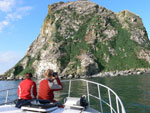
Imagine bobbing in a boat, salt spray peppering your face, a hat pulled down over your ears, pressing binoculars to your eyes counting thousands of seabirds for hours on end.
That is how Fish and Game biologists Marian Snively and Joe Meehan have spent much of their time the past two summers, along with U.S. Fish and Wildlife biologist Deb Rudis and three Fish and Game volunteers, Laura Kruger, Andy Reeves and Lisa Meehan.
The team surveyed nesting populations of seabirds in ...
100,000 Seabirds ArticleContinued
Fish That Like it Cold
November Delta Chums
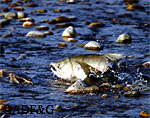
“Are we there yet?”
As parents we are accustomed to hearing the phrase from our young children on extended road trips. For chum salmon migrating more than 1,000 miles from the ocean to the Delta River, by the time they arrive, it's winter.
Chum salmon travel 690 miles up the Yukon River and take a right on the Tanana River, the largest tributary to the Yukon, then up the Tanana another 340 miles to the Delta River, an incredible journey of 1,030 miles. This freshwater trip ...
November Delta Chums ArticleContinued
ASK A WILDLIFE BIOLOGIST
How are Muskrat Push-ups Made?

Do all bears hibernate? How do wood frogs freeze solid? How far can caribou migrate? If you've you ever wondered anything about Alaska's wildlife, here is your chance to ask. Email your questions to wildlife educator Elizabeth Manning (elizabeth.manning@alaska.gov) and she will try to find an answer from Fish and Game or other wildlife agency biologists. Each month, we will highlight one of the inquiries in Alaska Wildlife News. Here is this month's question, and answer:
Annette ...
Muskrat Push-ups ArticleContinued
Wildlife Education is More than Teaching
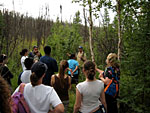
Teaching bear safety, recruiting citizen scientists, and helping teachers understand wildland fires and wildlife management – these are some of the tasks taken on by educators with the Division of Wildlife Conservation.
These are not the only educators with the Alaska Department of Fish and Game. Others focus on aquatic education or hunter education. But this month we'll meet five education and outreach specialists with wildlife conservation, based in Anchorage, Juneau, Fairbanks and Nome. ...
Wildlife Educators 1 ArticleContinued
Wildlife Educators 2
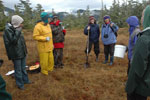
KRISTEN ROMANOFF is based in Juneau and her work focuses on Southeast. Juneau and neighboring Douglas are built on prime bear habitat and urban bear issues plagued these communities. Early this decade city police and fish and game received more than 1,000 calls each summer – about a dozen every night – about bear problems. Bears were shot, property was damaged, and thousands of hours were spent chasing bears around town. But bears weren't the cause of the problems; people and trash were the problem.
Part ...
Wildlife Educators 2 ArticleContinued
Community Voices in Fish and Game Regs

The Alaska Joint Boards of Fisheries and Game met in October in Anchorage for the first time in more than a decade. This unusual meeting of the combined boards was intended in part to address regulations concerning local fish and game advisory committees – the statewide network of grass roots organizations that discuss fish and wildlife management and recommend changes to hunting and fishing regulations.
The meeting provided a good venue for much-needed discussion about the structure ...
Advisory Committees ArticleContinued
Mobile Classroom Brings Lakes to Kids
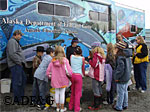
“What aquatic animal has 32 brains?”
“The leech!”
Lukas Patten grinned as he was given an Alaska Department of Fish & Game tattoo sticker for the correct answer to the question posed by Tracy Smith, an Education Associate for the Department.
On a recent brisk and colorful September day, approximately 100 students, teachers and parents joined the Alaska Department of Fish and Game staff for a study of Skilak Lake on the Kenai National Wildlife Refuge. Students from ...
A Lake at School ArticleContinued
